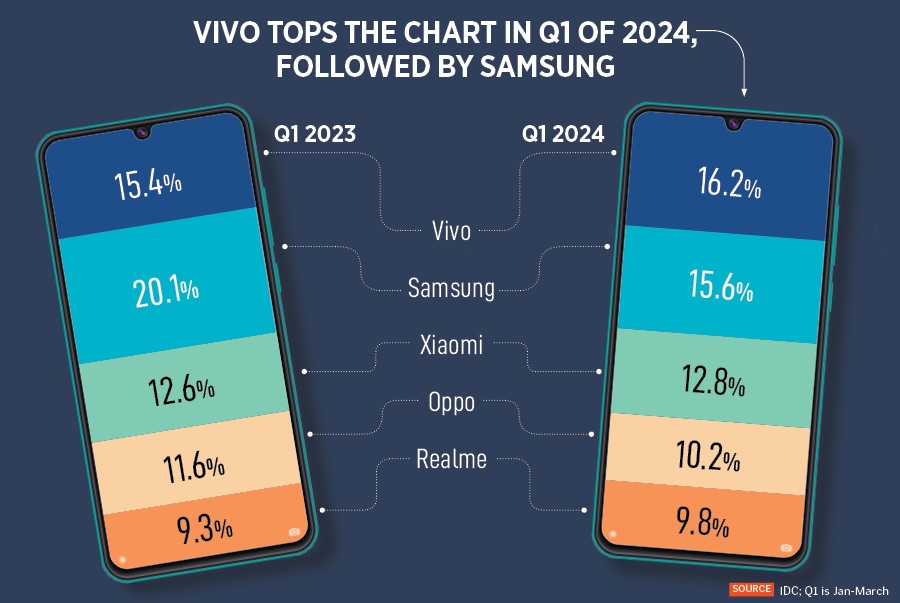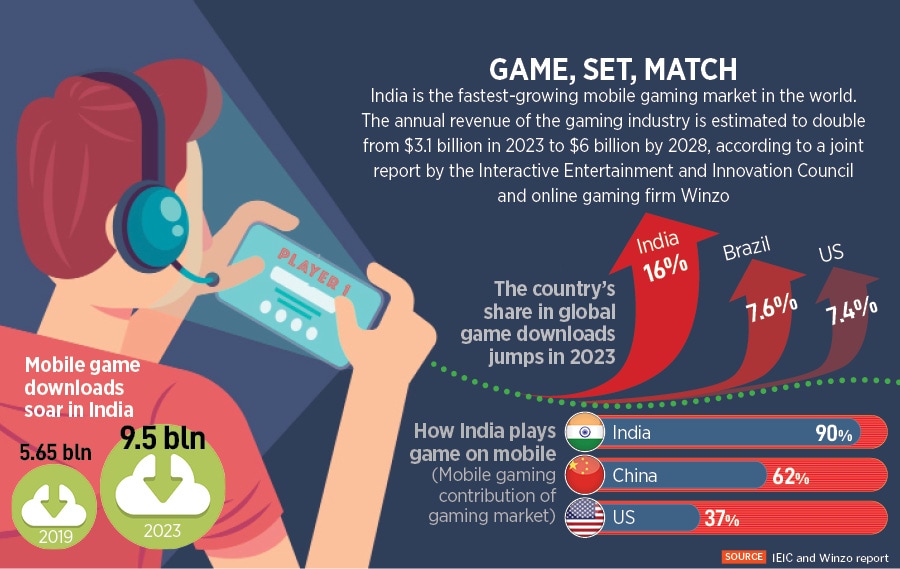Offline, Online & Vivo: A Game of Quarters
A strong offline presence, a dominant online play, and a smart sub-brand in iQOO, Vivo has yet again pipped Samsung in the quarterly sweepstakes. Can the Chinese phone maker finally wrest the annual t


April 2020. It seemed like an April Fool’s prank. “Vivo overtook Samsung for the first time in India," declared Canalys. In its quarterly smartphone pecking report released in April 2020, the global technology market analyst firm highlighted something that might have been branded absurd a year ago. Vivo, Canalys underlined, grew its shipments by nearly 50 percent, and emerged as the second biggest player in the first quarter of 2020 (January-March). The Chinese smartphone major notched a market share which was a tad below 20 percent. Contrast it to the pecking order which reigned supreme during the first quarter of 2019. Vivo: 12 percent Samsung: 23 percent. A drastic change in Vivo’s fortune in twelve months baffled the onlookers. “Can the Chinese upstart take on the South Korean giant or is the performance just a flash in the pan," was the larger question that begged for an answer.
Industry experts, however, were busy answering another interesting question. “Vivo’s victory is bitter-sweet," Canalys’ analyst Madhumita Chaudhary sounded a word of caution in her post-mortem of the quarterly report that stunned the pundits. The high volume notched by Vivo, she explained, was mainly due to planned stockpiles ahead of the Indian Premier League (IPL). However, with the pandemic playing a spoiler, IPL getting postponed, and a huge inventory in the offline channels getting blocked, Vivo’s blockbuster party was all set to get gate-crashed. “Vivo will struggle to see a quick sell-through when the lockdown lifts," the analyst noted.
The prophecy came true. In the second quarter of 2020 (April-June), Samsung boomeranged from 16 percent to 26 percent, according to Counterpoint Research, another global technology market research firm. The Korean darer slipped to its regular standing of third in the pecking order. In January 2022, Vivo pulled out of IPL title sponsorship, and, over the next few quarters, its market share dropped and eyeballs vanished. Though the relentless challenger kept hunting for another coup—there were some close moments such as 17:15 in favour of Samsung in the third quarter of 2021, and 19:17 in the second quarter of 2022—the adamant Korean zealously guarded its ranking. Despite a flurry of feisty onslaughts by the Chinese, nothing changed.

Then came the second quarter of 2023. Vivo managed to pip Samsung to become the biggest smartphone player in the quarter. The margin, though, was slender. Vivo’s 16 percent versus Samsung’s 15.7. Over the next two quarters, though Samsung reclaimed the top spot, the Chinese rival kept on closing the gap. Six months later, in the first quarter of 2024, Vivo again sprinted ahead of Samsung by grabbing a 16.2 percent volume market share as compared to Samsung’s 15.6 percent. Though this is the third time in as many years that Vivo has trounced its formidable Korean rival, the latest quarterly victory happens to be sweetest, and decisive, on multiple counts.
First, it puts to rest all speculation around the theory that Vivo’s first quarterly win in April 2020 was a fluke. “If you are beating the leader three times, and have come close to overtaking it on several occasions, it can’t be a coincidence," reckons Faisal Kawoosa, founder of techARC, a technology analytics, research, and consulting firm. “It’s not fifteen minutes of fame," he underlines. A player, Kawoosa underscores, which happens to be the only one among the top five smartphone brands in India to grow in 2023, has to be a serious contender for the throne. Second, the topping of the chart also underlines the resilience of the brand that has been involved in regulatory skirmishes with the government over alleged tax evasions and lapses in compliance.

Third, Vivo’s unflagging persistence also brings home the point that the smartphone maker is quick to adapt and learn from its much-nimbler Chinese counterparts such as Xiaomi, Realme, and Oppo who had amped up their online game, which helped them notch up their volume game too. And last, the Indian smartphone hierarchy is set to witness a prolonged, cut-throat battle between Vivo and Samsung, who will keep swapping positions over the next few quarters.
Now, the big question is: Can Vivo take pole position in four consecutive quarters to trump Samsung and take the annual throne from the South Korean major? The analysts are upbeat. The key to the future, they reckon, lies in understanding the current dynamics of the smartphone market, which is poised to remain the same over the next few quarters. First, let’s decode the tectonic shift in the Indian smartphone market.

The share of the entry-level segment—under $100 or Rs 8,327—is dwindling. From 20 percent a year ago, it has dipped to 15. The next rung is the belly of the market: The mass budget segment, which is between $100-$200 or Rs 8,327-Rs 16,654. In the first quarter of this year, this chunk grew by 22 percent YoY (year over year), and now makes up a staggering 48 percent of the smartphone market. Vivo lords over this segment.
Look at the volume share. From 53 percent in the first quarter of 2023, it has jumped to 63 percent in the corresponding quarter of this year (see box). “Vivo’s diversified portfolio and its spread across price segments—especially the mass and mass-mid segment—have ensured its sustained play," contends Navkendar Singh, associate vice president, (client devices & IPDS) at IDC India. The phone maker’s key focus has been on growing the mass market, and it has lined up more launches in the Rs 10,000 to 20,000 bracket over the next few quarters. “It has the right model mix, and channel strategy to be amongst the leaders in upcoming quarters as well," reckons Singh, who is quick to add that the Chinese brand was able to navigate the regulatory headwinds better than its counterparts. “Though scrutiny by the Indian government did impact the performance of the Chinese brands, Vivo was able to maintain its play," he says.

Forbes India reached out to the company, but Vivo declined to comment.
Streamlining local operations also played a role in pushing sales. Singh explains. Vivo’ s state teams, which acted as independent companies, were rejigged and brought under the parent umbrella, which helped in close monitoring and running a well-oiled and centralised machinery. What also helped in outperforming rivals was keeping a sharp focus on offline (brick and mortar) medium, which has always been a strong point for the Chinese player. A strong offline presence, prioritising the offline retailers and distributors with timely price corrections, schemes and offers, and support to end-of-life models--the ones which are in the final stages of being discontinued—did their bit in ramping up sales.

What, though, tilted the scales and gave an extra edge to Vivo was the launch of its online-first sub-brand iQOO, which stands for “I quest on and on." The rollout plugged a crucial gap in the armoury of the brand, which had so far failed to ace the online game as compared to its Chinese counterparts. Consider this. Xiaomi has two sub-brands: POCO and Redmi Oppo has OnePlus and Realme and Huawei had Honor before selling off the brand in 2021. iQOO, reckon industry experts, was more than an online-first product. It targets mobile gamers in India with its high-tech and spec combination. “The average selling price of Vivo in the first quarter of this year was $182 (Rs 15,158) as compared to $300 (Rs 24,987) for iQOO," says Singh. An exploding mobile gaming market provided the perfect tailwind for the brand to take off. India is the fastest-growing mobile gaming market in the world. The mobile game downloads soared from 5.65 billion in 2019 to 9.5 billion in 2023 (see box). “The online and premium play of sub-brand iQOO has helped them a lot," reckons Tarun Pathak, research director at Counterpoint Research.

Pathak points out a lesser-talked-about and underplayed factor that helped Vivo in its furious march. “It has had encouraging success in cracking the premium—entry as well as mid-tier—market," he says. It’s not easy for a company, especially one that has built its foundation and appeal as a mass-budget brand—to graduate to the premium market and give a fight to the likes of Samsung, OnePlus, and others. Vivo’s success in India, he explains, must be seen in the global context as well. In the first quarter of this year, the Chinese phone maker topped the Indonesian smartphone market by cornering a 19.2 percent volume share. Samsung came fourth in the pecking order and trailed Xiaomi and Oppo, which occupied second and third place, respectively.
Back home in India, handset experts reckon that Vivo stands a strong chance of unsettling Samsung’s regime. The catch, though, is the resolution of its protracted legal tussle with the government agencies. “We have seen what happened with Xiaomi," says an analyst requesting anonymity. “From a high of 31 percent in the first quarter of 2020, it has slipped to 15.8 percent in the first quarter of last year," he says, adding that the brand did manage to add on to its market share in the corresponding quarter of this year by notching up 18.8 percent. “Vivo’s future depends on how well it plays the game of Chinese Checker with the Indian authorities," he says. The brand has done well in crafting and executing a strategy that revolves around the principle that online is vanity, offline is sanity and the hybrid model is the king. “The question now is can Vivo get its pieces in order," he asks.
The jury is still out.
First Published: May 21, 2024, 16:46
Subscribe Now